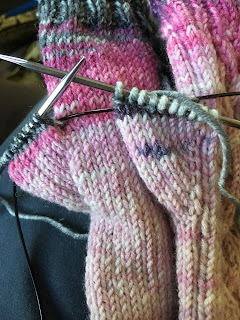I'm in the camp with those who love it. "If it's round use magic Loop" is my mantra. "If it's round and there are two of them do two-at-a-time magic loop," I always say.
I have been knitting lots of fingerless mitts for Knits for Knowledge, and let me tell you, it's so much easier with magic loop. I can keep my pattern straight, I complete the pair together. Here's how a pair looks as I'm knitting them.
Now, within that "I love magic loop" camp there is a subset of radicals who even use magic loop for very small round things.
Seriously?!?! Does that even work? Yes, it absolutely does!
Yes, you guessed it, I'm one of those radicals. Here's my rationale. Why would I want to use four or five needles to knit something that is only eighteen, twelve, ten (pick a number) stitches around? That's too much fumbling for me.
So, to illustrate, in these fingerless mitts, I'm showing you how I do the thumbs with magic loop two-at-a-time.
This collage shows steps in the process.
- Top left - reserved thumb stitches
- Top right - first half of thumb stitches transferred the front needles
- Lower left - all thumb stitches transferred, waste yarn is still through the reserved stitches
- Lower right - one round knitted, the second strand is tucked inside the thumb
Thumbs completed and ready for bind-off. (I'm planning a post about binding off in magic loop.)
I hope you've enjoyed this post and it gives you confidence to use magic loop for loads of round knitting.






